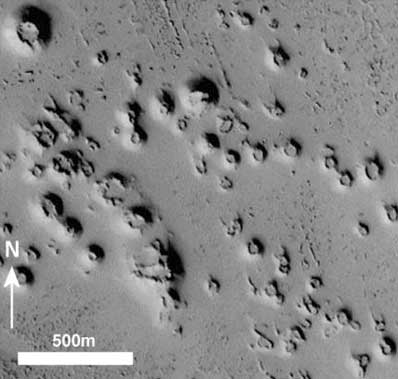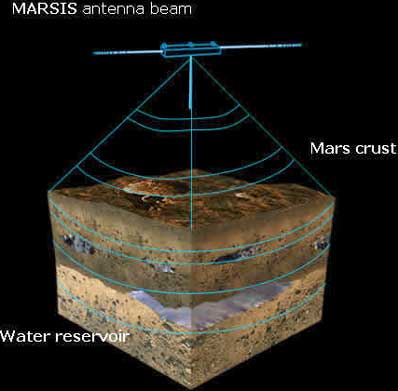
European probes to identify underground water on Mars
EUROPEAN SPACE AGENCY SCIENCE RELEASE
Posted: August 28, 2001
Geologists poring over the latest images from Mars keep on turning up new and tantalising evidence that water once flowed freely on the planet's surface - and may still flow from time to time. If their interpretation is right, underground aquifers or ice layers should be commonplace on the planet. Yet no spacecraft flown so far has been capable of identifying them.

'Rootless cones' on Mars, seen in this image from the Mars Global Surveyor spacecraft, suggest the existence of near-surface groundwater or ice, as the cones form when water or ice interacts explosively with surface lava. Photo: LPL/NASA
|
All that should change in a few years, however, with the first European missions to the Red Planet. The European Space Agency's Mars Express followed by the Netlanders, lead by the French space agency, CNES, will be the first missions capable of prospecting directly for underground water on Mars. A gamma-ray spectrometer on board NASA's Mars Odyssey, which arrives at the planet later this year, will look for the chemical signature of water on the surface of the planet, but will not be able to penetrate far underground.
The European missions were among the hot topics for discussion in Houston, Texas, earlier this month at a conference* to help determine future strategy in the search for water on Mars. "The consensus was that Europe is now at the forefront of the geophysical investigation of Mars," says Agustin Chicarro, project scientist for Mars Express.
Ground penetrating radar from orbit
Mars Express will carry a ground penetrating radar, called MARSIS, into polar orbit around Mars in 2003. Much like airborne radar that prospects for underground minerals on Earth, MARSIS will attempt to locate different layers, including layers of water and ice, in the top 5 km of Martian crust.

MARSIS aboard Mars Express will use ground penetrating radar to prospect for water on Mars. Illustration: ESA/medialab
|
The Italian space agency, ASI, is proposing to fly a modified version of MARSIS, called SHARAD, on NASA's 2005 orbiter to look for water in the top few hundred metres of crust. The SHARAD proposal was made after images recently returned from NASA's Mars Global Surveyor suggested that water has flowed on Mars in the recent past and hence could be close to the surface in some regions.
Seismic sounding
In 2007, Europe will send four small Netlanders to different locations on the Martian surface from where they will probe the planet's interior. In much the same way that geologists on Earth use seismic methods to locate oil or mineral deposits, they will be the first craft ever to sound the Martian interior seismically. Much should be revealed about the structure and composition of Mars' interior, including the location of buried water and ice. "If you put a seismometer on the surface of Mars, you can determine whether the planet is wet or dry. If it rings like a bell, then it's dry like the Moon," says Chicarro.
Mars Express and the Netlanders represent the first steps in the geophysical exploration of Mars. The conference participants discussed what should happen next, in particular in 2009 when NASA may send a major geophysical mission to the planet. The first aim of any future strategy, the conference agreed, should be to determine the global distribution of possible underground water sources, followed by a more precise determination of local sources and finally the selection of specific sites for drilling.
What next?
The shape of the 2009 mission will depend on how far Mars Express, the Netlanders and NASA's 2001, 2003 and 2005 missions have gone along the way. Will they have produced a good enough map of the global distribution of underground water to move to step two? May they even have done enough groundwork to move straight to step three, drilling? The trouble is that NASA cannot afford to wait for the answers to these questions. Plans for the 2009 mission need to be agreed soon.
One idea discussed at the conference is to supplement the Netlanders with up to 20 more small landers to provide detailed information local to widely dispersed sites. Each lander could carry instruments capable of mapping underground structures to a depth of a few tens of metres. The conference delegates discussed the relative merits of two techniques for doing this, electromagnetic sounding and ground penetrating radar. Both techniques are widely used on Earth and ground-penetrating radar will be used on the Netlanders. "These techniques provide better accuracy than radar from orbit or seismic sounding because they are done on a smaller scale," explains Chicarro. Electromagnetic sounding could also be carried out from balloons flying in the Martian atmosphere and ground-penetrating radar from rovers.
The culmination of the exploration effort will be to send a lander capable of drilling deep into the Martian crust to determine whether it really is water down there. Some conference delegates were keen to see this achieved in 2009 and one major oil drilling company has reportedly already begun work to develop a suitable drill.
Water or carbon dioxide?
Nick Hoffman from La Trobe University, Melbourne, Australia, however, warned that a drill could release something other than water - liquid carbon dioxide (CO2). The conference heard that many of the remote sensing detection methods discussed would be hard pressed to distinguish between water, water-ice and liquid or solid carbon dioxide, but choosing methods capable of such a distinction is important because leaving it until the drilling phase could be hazardous. "Drilling into an overpressured liquifer will lead to a potential blow-out of gaseous CO2 which may cause severe damage to the drilling equipment and endanger any nearby facilities and personnel," warns Hoffman.
Many of the features in the Martian landscape attributed to water, including the outburst flow channels, could have been caused by the outpouring of liquid carbon dioxide or a mixture of carbon dioxide and water, thinks Hoffman. If this is the case, then the problem of explaining how Mars' climate changed from warm and wet to cold and dry is eliminated: the planet need never have been warm and wet. "People were listening to these ideas seriously. We won't know whether they're right or not until future missions have given us more information. But we need to bear them in mind when interpreting our data," says Chicarro.

|
 |
 |
 |






|

